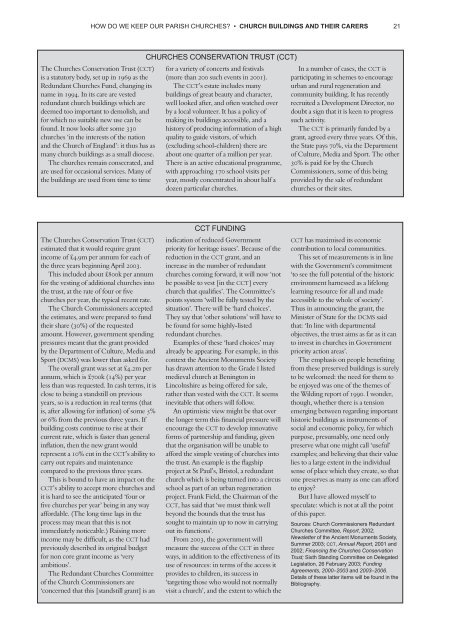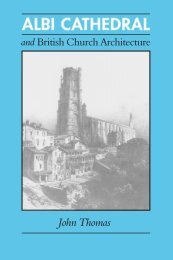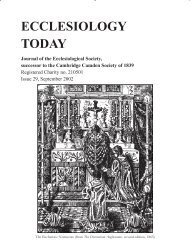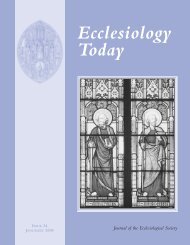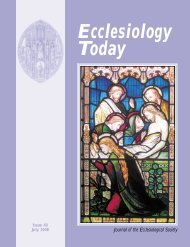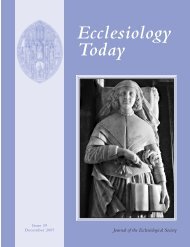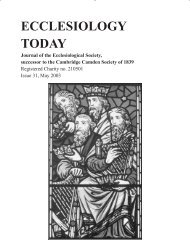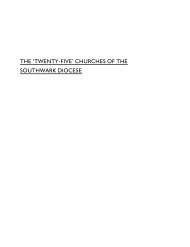PARISH CHURCHES? how do we keep our - Ecclesiological Society
PARISH CHURCHES? how do we keep our - Ecclesiological Society
PARISH CHURCHES? how do we keep our - Ecclesiological Society
Create successful ePaper yourself
Turn your PDF publications into a flip-book with our unique Google optimized e-Paper software.
HOW DO WE KEEP OUR <strong>PARISH</strong> <strong>CHURCHES</strong>? • CHURCH BUILDINGS AND THEIR CARERS 21<br />
The Churches Conservation Trust (CCT)<br />
is a statutory body, set up in 1969 as the<br />
Redundant Churches Fund, changing its<br />
name in 1994. In its care are vested<br />
redundant church buildings which are<br />
deemed too important to demolish, and<br />
for which no suitable new use can be<br />
found. It now looks after some 330<br />
churches ‘in the interests of the nation<br />
and the Church of England’: it thus has as<br />
many church buildings as a small diocese.<br />
The churches remain consecrated, and<br />
are used for occasional services. Many of<br />
the buildings are used from time to time<br />
<strong>CHURCHES</strong> CONSERVATION TRUST (CCT)<br />
for a variety of concerts and festivals<br />
(more than 200 such events in 2001).<br />
The CCT’s estate includes many<br />
buildings of great beauty and character,<br />
<strong>we</strong>ll looked after, and often watched over<br />
by a local volunteer. It has a policy of<br />
making its buildings accessible, and a<br />
history of producing information of a high<br />
quality to guide visitors, of which<br />
(excluding school-children) there are<br />
about one quarter of a million per year.<br />
There is an active educational programme,<br />
with approaching 170 school visits per<br />
year, mostly concentrated in about half a<br />
<strong>do</strong>zen particular churches.<br />
In a number of cases, the CCT is<br />
participating in schemes to enc<strong>our</strong>age<br />
urban and rural regeneration and<br />
community building. It has recently<br />
recruited a Development Director, no<br />
<strong>do</strong>ubt a sign that it is keen to progress<br />
such activity.<br />
The CCT is primarily funded by a<br />
grant, agreed every three years. Of this,<br />
the State pays 70%, via the Department<br />
of Culture, Media and Sport. The other<br />
30% is paid for by the Church<br />
Commissioners, some of this being<br />
provided by the sale of redundant<br />
churches or their sites.<br />
The Churches Conservation Trust (CCT)<br />
estimated that it would require grant<br />
income of £4.9m per annum for each of<br />
the three years beginning April 2003.<br />
This included about £800k per annum<br />
for the vesting of additional churches into<br />
the trust, at the rate of f<strong>our</strong> or #ve<br />
churches per year, the typical recent rate.<br />
The Church Commissioners accepted<br />
the estimates, and <strong>we</strong>re prepared to fund<br />
their share (30%) of the requested<br />
amount. Ho<strong>we</strong>ver, government spending<br />
pressures meant that the grant provided<br />
by the Department of Culture, Media and<br />
Sport (DCMS) was lo<strong>we</strong>r than asked for.<br />
The overall grant was set at £4.2m per<br />
annum, which is £700k (14%) per year<br />
less than was requested. In cash terms, it is<br />
close to being a standstill on previous<br />
years, so is a reduction in real terms (that<br />
is, after allowing for in$ation) of some 5%<br />
or 6% from the previous three years. If<br />
building costs continue to rise at their<br />
current rate, which is faster than general<br />
in$ation, then the new grant would<br />
represent a 10% cut in the CCT’s ability to<br />
carry out repairs and maintenance<br />
compared to the previous three years.<br />
This is bound to have an impact on the<br />
CCT’s ability to accept more churches and<br />
it is hard to see the anticipated ‘f<strong>our</strong> or<br />
#ve churches per year’ being in any way<br />
affordable. (The long time lags in the<br />
process may mean that this is not<br />
immediately noticeable.) Raising more<br />
income may be dif#cult, as the CCT had<br />
previously described its original budget<br />
for non core grant income as ‘very<br />
ambitious’.<br />
The Redundant Churches Committee<br />
of the Church Commissioners are<br />
‘concerned that this [standstill grant] is an<br />
CCT FUNDING<br />
indication of reduced Government<br />
priority for heritage issues’. Because of the<br />
reduction in the CCT grant, and an<br />
increase in the number of redundant<br />
churches coming forward, it will now ‘not<br />
be possible to vest [in the CCT] every<br />
church that quali#es’. The Committee’s<br />
points system ‘will be fully tested by the<br />
situation’. There will be ‘hard choices’.<br />
They say that ‘other solutions’ will have to<br />
be found for some highly-listed<br />
redundant churches.<br />
Examples of these ‘hard choices’ may<br />
already be appearing. For example, in this<br />
context the Ancient Monuments <strong>Society</strong><br />
has drawn attention to the Grade I listed<br />
medieval church at Benington in<br />
Lincolnshire as being offered for sale,<br />
rather than vested with the CCT. It seems<br />
inevitable that others will follow.<br />
An optimistic view might be that over<br />
the longer term this #nancial pressure will<br />
enc<strong>our</strong>age the CCT to develop innovative<br />
forms of partnership and funding, given<br />
that the organisation will be unable to<br />
afford the simple vesting of churches into<br />
the trust. An example is the $agship<br />
project at St Paul’s, Bristol, a redundant<br />
church which is being turned into a circus<br />
school as part of an urban regeneration<br />
project. Frank Field, the Chairman of the<br />
CCT, has said that ‘<strong>we</strong> must think <strong>we</strong>ll<br />
beyond the bounds that the trust has<br />
sought to maintain up to now in carrying<br />
out its functions’.<br />
From 2003, the government will<br />
measure the success of the CCT in three<br />
ways, in addition to the effectiveness of its<br />
use of res<strong>our</strong>ces: in terms of the access it<br />
provides to children, its success in<br />
‘targeting those who would not normally<br />
visit a church’, and the extent to which the<br />
CCT has maximised its economic<br />
contribution to local communities.<br />
This set of measurements is in line<br />
with the Government’s commitment<br />
‘to see the full potential of the historic<br />
environment harnessed as a lifelong<br />
learning res<strong>our</strong>ce for all and made<br />
accessible to the whole of society’.<br />
Thus in announcing the grant, the<br />
Minister of State for the DCMS said<br />
that: ‘In line with departmental<br />
objectives, the trust aims as far as it can<br />
to invest in churches in Government<br />
priority action areas’.<br />
The emphasis on people bene#ting<br />
from these preserved buildings is surely<br />
to be <strong>we</strong>lcomed: the need for them to<br />
be enjoyed was one of the themes of<br />
the Wilding report of 1990. I wonder,<br />
though, whether there is a tension<br />
emerging bet<strong>we</strong>en regarding important<br />
historic buildings as instruments of<br />
social and economic policy, for which<br />
purpose, presumably, one need only<br />
preserve what one might call ‘useful’<br />
examples; and believing that their value<br />
lies to a large extent in the individual<br />
sense of place which they create, so that<br />
one preserves as many as one can afford<br />
to enjoy?<br />
But I have allo<strong>we</strong>d myself to<br />
speculate: which is not at all the point<br />
of this paper.<br />
S<strong>our</strong>ces: Church Commissioners Redundant<br />
Churches Committee, Report, 2002;<br />
Newsletter of the Ancient Monuments <strong>Society</strong>,<br />
Summer 2003; CCT, Annual Report, 2001 and<br />
2002; Financing the Churches Conservation<br />
Trust; Sixth Standing Committee on Delegated<br />
Legislation, 26 February 2003; Funding<br />
Agreements, 2000–2003 and 2003–2006.<br />
Details of these latter items will be found in the<br />
Bibliography.


